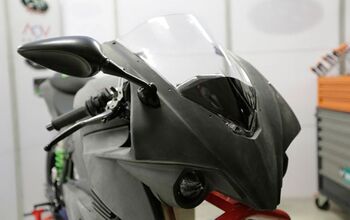What's the Range of an Electric Motorcycle?

Trying to figure out the range of an electric motorcycle is like competing in an eating contest: You think you know the limits, but you’re never quite sure until you’ve gone too far. Nonetheless, we at Motorcycle.com are fortunate enough to have ridden many of the electric motorcycle offerings out there, and at the very least, this gives us a starting point when discussing the range you can expect from an electric.
To go over the range of each electric motorcycle available today would be a daunting task. Instead, let this serve as a broad overview of what you can expect. The short answer to the range question, of course, is that it’s complicated. Manufacturers will claim one thing, but in reality, the mileage you actually get is vastly different. Companies like Zero Motorcycles try to be relatively helpful by listing mileage figures for certain riding conditions like City, Highway, and combined, but just as it is with internal combustion engines, your mileage may (and most likely will) vary.
We can, however, draw some parallels with internal combustion engines. Ride with the throttle pinned everywhere, and that’s a sure-fire way to deplete your available electrons as quickly as possible. Conversely, if you ride like grandma, it’s possible you might even surpass the manufacturer-suggested mileage. Find a happy medium, and you’ll average out to what the manufacturer claims.
However, the types of roads you ride on will affect your range, too. Sustained, high-speed riding, like on your average freeway, eat battery power quickly while low-speed traffic is ideal for maximizing an EV’s range. As a bonus, if you find yourself in plenty of stop-and-go, it’s also possible to add back a tiny bit of range, depending on the regenerative braking settings of the vehicle.
What about some numbers?
Fine. For the purposes of this summary let’s take a 2018 Zero S with the ZF13.0 battery pack as our sample. This means our sample Zero’s battery has a max capacity of 13.0kWh, and a nominal capacity of 11.4kWh. Zero claims city mileage to be 161 miles, which includes stop-and-go traffic and “operation typically found in urban areas,” at least according to the SAE J2982 Riding Range Test Procedure for On-Highway Electric Motorcycles. We’ve never had the opportunity to fully explore this mileage claim, mostly for the fact that doing so would be incredibly boring.
What we have done, however, is ride a number of Zeros in real-world situations, including highway riding, a situation Zero also has a mileage number for, under “Combined.” In this scenario, 50% of the urban riding mentioned earlier is mixed with another 50% of highway riding that allow for “quasi-steady speeds of 70 mph.” Again, each of these tests are performed to the SAE J2982 standard. Here, Zero claims 60 miles for the ZF7.2 battery pack and 108 miles for the ZF13.0 battery, and in our experience these numbers have been fairly accurate.
For numbers that aren’t from Zero, we turn to the 2018 BMW C Evolution. The urban mobility scooter, as BMW prefers to call it, is an excellent use for an electric as scooter riding encompasses the perfect scenarios for an electric. Here, BMW says the C Evolution can travel up to 99 miles on a charge. We never came close to that number, but could routinely ride 70 miles under normal conditions – as in, riding like we normally would any other motorcycle.
From what we’ve seen, electric motorcycle manufacturers aren’t trying to trick the motorcycling public about how far their motorcycles can travel on a full charge. In fact, being as accurate as possible gives the potential customer as much knowledge as possible for their purchase, and credibility is huge for the electric market, as the industry tries to fight for viability among many critics who have written off the technology. The availability of on-site charging opportunities at your destination can have a big impact on whether electrics are right for you, but for many – but not all – electric motorcycles have more than enough range for their one-way daily commute. Then the question becomes: Where Do You Charge Your Electric Motorcycle?

Motorcycle.com presents an unrivaled combination of bike reviews and news written by industry experts
More by Motorcycle.com Staff































Comments
Join the conversation
there are several actual options in the market today, one for example is the company Zero in Usa, they have eletric motorbike which go upto 120miles per hr/600 appx miles one charge distance/at a price of $15.000 base model and upto 25.000 or so, but they fall in the category of must have a driver licence/insurance/licenceplate......and so many seller in the range of 350/500/1000/1500 watts power from $999.00 upto $ 5.ooo or so,
still operable without lic/etc.etc. the point is you can powerup a regular 48watts power upto 108watts by adding batteries number and motor controller keeping the same bike, and staying with the no lic/place etc but the speed limit by law is still at 32km or pay a hefty fine and be charged or loose the bike.................so if y have the money u can buy the Zero, if you don t have the licence etc. you go for the standard, in my opinion
with increasing volume of traffic in the future, i would advocate for a proper driver licence plate number and insurance (at a levelled cost proportion), and divide the first type of electric bike for power and speed at minimum/maximum 60kms, with a 2hours charge up and drivable upto at least 100kms one charge, and licence all gas stations and mechanic etc, to installed charging station, my opinion ofcourse, mauro cv
I'm confused, Zero claims 108 miles of range with the 13kW pack of there Zero S using the SAE J2982 testing standard. You say that you were only able to achieve 60 miles of range with this test. If this is the case using the phrase "been fairly accurate", is a bit misleading, No?